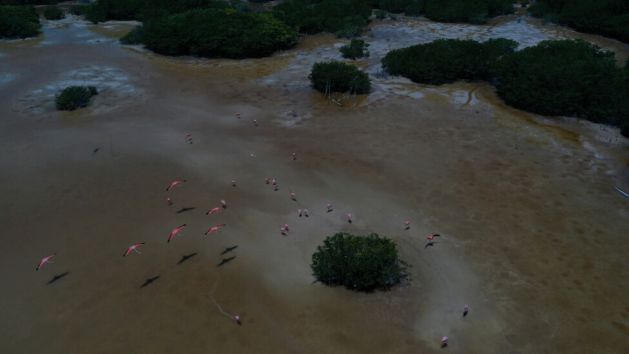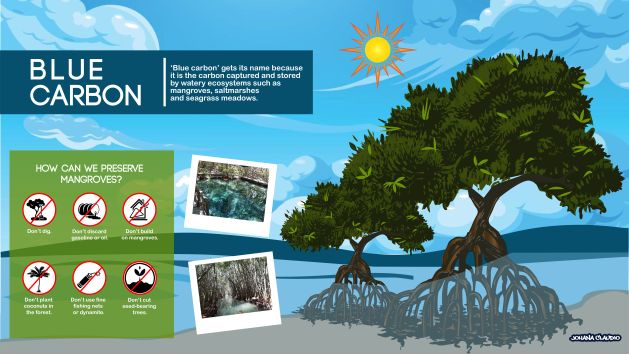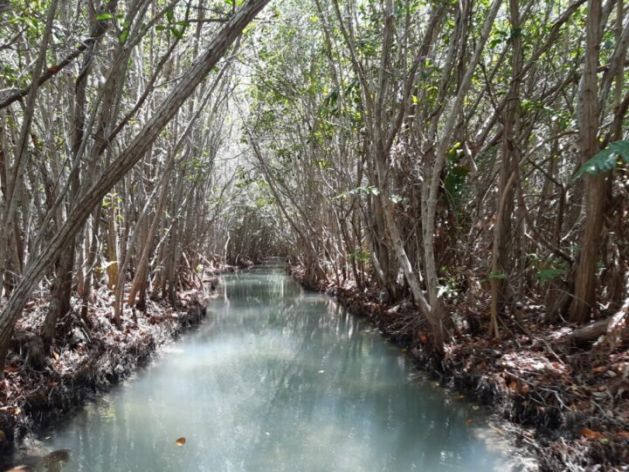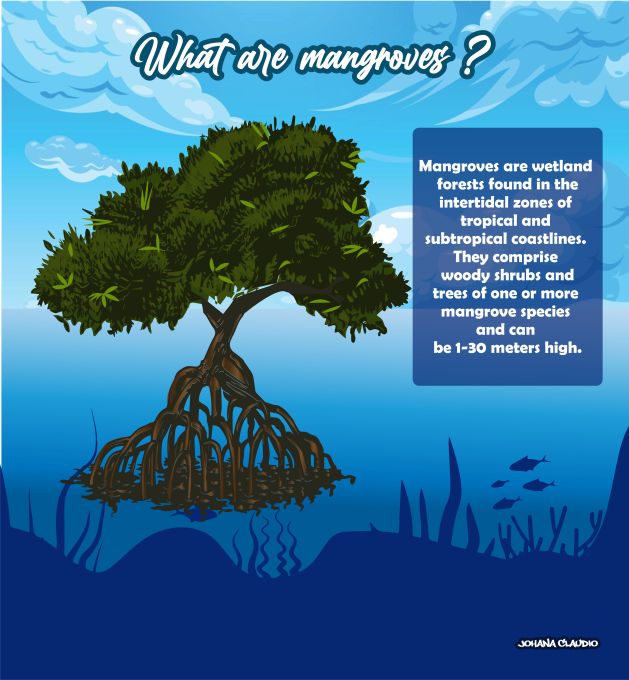Mexico’s Blue Carbon Pioneers Push on Despite Lack of State Support

SINANCHÉ, Mexico, Jul 27 (IPS) - When hurricanes Opal and Roxanne both hit the Mexican state of Yucatán in a ten-day period in 1995, they destroyed much of the mangrove forest in the small coastal community of San Crisanto. The local people responded by replanting mangroves and clearing channels among the trees to allow water to flow freely. They committed to protect the ecosystem.
Today it’s a conservation success story, with the restored mangroves protecting the coastline, sustaining wildlife and supporting livelihoods based on fishing and ecotourism. Now, after 27 years of hard work, the community is reaping new benefits by capitalizing on the carbon the mangroves contain. They are selling Mexico’s first carbon credits based on the so-called ‘blue carbon’ of marine ecosystems.
“We have been the first to do so,” says to IPS José Loria, the president of the community’s San Crisanto Foundation. “We are pioneers. We built the project, we designed it. It is a meaningful issue, relevant to the area. It's a long-term project.”
Mexico has huge reserves of blue carbon and, as San Crisanto shows, it can generate finance that supports conservation and sustainable livelihoods.
But Mexico has no national policies and plans for tapping into this potential, and blue carbon gets scant mention in the country’s climate change commitments. Lacking support, communities, companies and nongovernmental organizations are pushing on anyway.

Rising market
Mangroves, seagrasses and salt marshes hold back waves, limit erosion and lessen the impacts of rising sea levels, so their conservation is a nature-based adaptation to the climate crisis.
But these ecosystems also capture and store vast amounts of organic carbon, so they play a key role in limiting the global heating that causes climate change in the first place. There comes its “blue carbon” name.
For the captured and stored carbon dioxide (CO2), the mangroves owners can issue certificates for selling in domestic and international markets to corporations interested in reducing their polluting emissions.
Companies and individuals can buy these credits on what is known as the voluntary carbon market to offset their greenhouse gas emissions — each credit represents the removal of one metric ton of carbon dioxide from the atmosphere.
In fact, a mangrove absorbs 5-10 times more carbon than a tropical forest of the same area.
This is especially relevant for Mexico, which has a greater area of blue carbon ecosystems than most other countries. In 2020, for example, it had 905 086 hectares of mangroves — only Indonesia, Australia and Brazil have more.
This means that Mexico is well-placed to benefit from the emerging trade in blue carbon credits.
“The voluntary carbon market is in full growth, as more and more companies are integrating carbon credits into their environmental strategies to complement the measurement and reduction of their emissions,” says Alessandra Souroujon, a senior analyst at Climate Seed — a carbon trade broker based in Paris.
“It is expected that this trend will continue to increase and, with it, more projects of this type will be developed.”
In an e-mail to IPS, Souroujon emphasized challenges, such as the cost of certification and the need for long-term community commitment and the right project partners.
She said the success of San Crisanto shows the potential for the trade in blue carbon to finance the conservation and restoration of mangroves, and to produce income to develop the community and improve the quality of life there.

San Crisanto shows how
San Crisanto is located in the Sinanché municipality, about 1 360 kilometers southeast of Mexico City. It is an ejido — an area of land owned by the state but held and managed communally by local people.
A few dozen meters from the village’s sea-bleached sandy streets, spreads a green blanket of tall, thin trees. They are the 850 hectares of mangroves that the community has preserved since 1995.
The forest has four species of mangrove trees: red mangrove (Rhizophora mangle), white (Laguncularia racemosa), black (Avicennia germinans) and buttonwood (Conocarpus erectus). It is a haven for fish, turtles, crocodiles and 167 bird species, including pink flamingos that have returned to the area after a gap of 50 years.
Having spent years counting species there, the local land managers are now counting how much blue carbon the mangroves hold.
The venture, with 125 000 dollars of investment from the ejido’s coffers, started in 2015 with the measurement of carbon in mangrove tree trunks and branches.
It took a few years of trial and error to get the methodology right before the ejido could report its data to a certification body for verification. This was completed in March 2022 by the Mexican subsidiary of the Colorado’s Ruby Canyon-based Ruby Canyon Environmental Inc.
Loria told IPS that the ejido’s carbon credits are being sold in the international voluntary market for more than 20 dollars per ton of carbon. This is a noteworthy fee — four times more than the price of carbon credits from some projects in terrestrial forests in Mexico. One European company producing luxury goods has already bought more than 10 000 offsets from the ejido.
But this is just the start. This year, the measurement of above-ground carbon totaled 25 tons per hectare. The number of offsets the ejido can sell is set to increase as the mangroves grow and once the ejido has also quantified the carbon in the roots and sediment.
“The revenues will strengthen the project," says Loria. In an announcement published on 31 May 2022, the San Crisanto Foundation said it would use the money generated by selling carbon credits “to maintain the mangrove forest, fund environmental education, strengthen local culture and traditions, and enhance public services, improving the community’s quality of life”.
Lost at sea
Despite Mexico’s potential, cases like San Crisanto happen in a vacuum as there is no national blue carbon strategy. In 2021, a non-governmental organization, The Nature Conservancy Mexico, produced a roadmap for developing such a strategy but it has not published it.
Blue carbon does feature in the commitments Mexico has made under the 2015 Paris Agreement on climate change, in a periodically updated document called a Nationally Determined Contribution (NDC).
The latest NDC, from 2020, mentions “strengthening instruments and executing actions for biodiversity conservation and the restoration of marine, coastal and freshwater ecosystems, as well as increasing and maintaining carbon reservoirs, with emphasis on blue carbon”.
The NDC notes that blue carbon can contribute to ten of the 17 Sustainable Development Goals that the international community adopted in 2015 at the United Nations to achieve by 2030. These include the goals on clean water, climate action, underwater life and terrestrial ecosystems.
Similarly, while the country’s Climate Change Strategy for Protected Natural Areas 2015-2040 aims to mitigate the climate crisis through carbon capture and storage, it only mentions blue carbon once, in relation to mapping the resource in those areas.
More than half of Mexico’s mangroves — some 464 000 hectares — are preserved in these areas, which are under the jurisdiction of the governmental National Commission of Protected Natural Areas (Conanp). They represent a great opportunity for blue carbon projects, but Conanp lacks precise CO2 measurements at each site.
This is a challenge as the carbon content of mangrove forests varies greatly. While San Crisanto has 25 tons of above-ground carbon per hectare, other mangroves in Mexico have several hundred tons.
There is even more carbon underground — as much as 1 000-2 000 tons per hectare. But while above ground carbon can be quantified with satellite-based measurements, CO2 in roots and sediments must be laboriously measured on site.
A Conanp document seen by IPS recommends advancing the quantification of blue carbon deposits, the formulation of regulations including to count emissions from coastal degradation, and the promotion of regulated trading schemes for offsets.
When IPS asked Conanp to comment about the lack of a national strategy, a spokesperson replied that, “it has not been possible to consolidate the efforts between the various stakeholders and the financing needed for the generation of an effective strategy, which contemplates the diversity of existing contexts”.
Conanp acknowledged that it seeks strategies to take advantage of the potential of the carbon market, “with special emphasis on all the mechanisms used being translated into social benefit of the legitimate holders of environmental assets".
It says, the roadmap for a strategy must cover at least a 10-year period and include the quantification of the contribution of blue carbon ecosystems to the climate action and the mobilization of climate finance for its management.
Joanna Acosta, a conservation biologist at the state-run Autonomous University of Carmen, located in Ciudad del Carmen (Campeche), says to IPS the environmental authorities already know what to do, but there has been no political will to move forward with policies that support blue carbon projects.
“They are long-term projects,” she says. “There has to be a very clear vision that it is meant to conserve and restore mangroves, and that the money from the offsets has to be invested again in the community. In Mexico we are not ready for carbon credits. There are many expectations, but nothing is clear.”
Acosta proposed a roadmap that generates institutional arrangements and clear rules, “so that each party knows what their responsibility is, from the community, which is close to the resource, to academia, in support of the community, and the government”.
Jorge Herrera, academic at the Center for Research and Advanced Studies of the state-run National Polytechnic Institute, says there is too much emphasis on carbon offsets, and that other conservation approaches are also needed to protect mangroves.
“The benefits depend on the carbon in the mangroves, not just the credits,” he told IPS. “What is least known is carbon in the soil, of which we know very little. Those in charge of the policies should explain why blue carbon mechanisms are missing.”

Slow carbon
Despite the absence of enabling policies, some blue carbon projects are trying to make progress. In Magdalena Bay, in the northern state of Baja California Sur, the private Corporación MarVivo is developing the MarVivo Blue Carbon Conservation Project in partnership with local communities. By conserving 22 000 hectares of mangroves, it aims to offset 26 million tons of CO2 emissions over 30 years.
In November 2021, the company and the US private corporation Carbon Streaming announced an investment agreement through which the latter will invest six million dollars in the implementation, with an initial disbursement of two million.
Upon the project reaching its goals, the fund will deliver four installments of one million dollars and will have the right to buy more than 200 000 credits each year.
Several other initiatives want to take off, but they face barriers, mainly financial.
Nongovernmental organization Costasalvaje’s Blue Carbon Project aims to protect 33 891 hectares of mangroves in the Gulf of California, in northern Mexico. The organization is working with the El Dátil community to restore degraded red mangroves in the El Vizcaíno Biosphere Reserve in the state of Baja California Sur.
It is also working with the women's group “Guardians of the Conchalito” to restore the mangroves of El Conchalito Estuary, near the state capital La Paz.
The organization has estimated that a 16 592-hectare area of mangroves in northwestern Mexico stores 20-million tons of carbon, equivalent to the emissions of 608 944 cars in a year.
On the southern side of the Gulf of California, in the western states of Nayarit and Sinaloa, TNC Mexico identified 80 000 hectares for protection and regeneration in the Marismas Nacionales Biosphere Reserve.
Closer to San Crisanto, in Yucatán state, the Sisal ejido in the Hunucmá municipality is preparing to launch the trade of carbon credits from 5 060 hectares of mangroves. It aims to sell 3.18 million credits over 30 years.
And in south-eastern Mexico, in Quintana Roo state, a consortium led by the non-governmental Resiliencia Azul is seeking 100 000 dollars to certify carbon and issue offsets in a project called Taab Ché (mangrove, in the indigenous Mayan language).
The project is working in the Yum Balam Flora and Fauna Protection Area, whose 7 265 hectares of mangroves are mostly in good condition, and the Isla Cozumel Natural Areas which have 3 011 hectares of mangroves, with almost half being well preserved.
A possible future
Back in San Cristanto, Loria says that other communities seeking to capitalize on the blue carbon in their mangroves will need trust and patience.
“They have to be sure of what they want to do,” he says. “If the community wants to, it doesn't need a national framework. We did it, period. It depends on the maturity of the organization, the work that has been done. It doesn’t happen by spontaneous generation.”
But Tannia Frausto, the climate change manager for Costasalvaje, stresses the need for policies that can be applied locally.
“If there was a national strategy, with clear policies and funding, and it was a priority, the conservation of those ecosystems could be sped up and prioritized,” she says. “Mangroves are already a resource we have, so the job is to take care of them. It is urgent to create the legal framework that allows optimizing resources. Environmental degradation is going faster than what can be protected with the current instruments.”
Frausto recommends closing the gap between investment and ecosystem recovery.
“At a global level, companies are going to need carbon offsets, not only to mitigate but because of a sense of social responsibility,” she says. “While offsets are not the ultimate goal, they allow entrepreneurs, bankers and communities to be brought together and seated at the same table. That's the added value.”
This story was produced with support from the Internews Earth Journalism Network.
© Inter Press Service (2022) — All Rights Reserved. Original source: Inter Press Service
 Global Issues
Global Issues